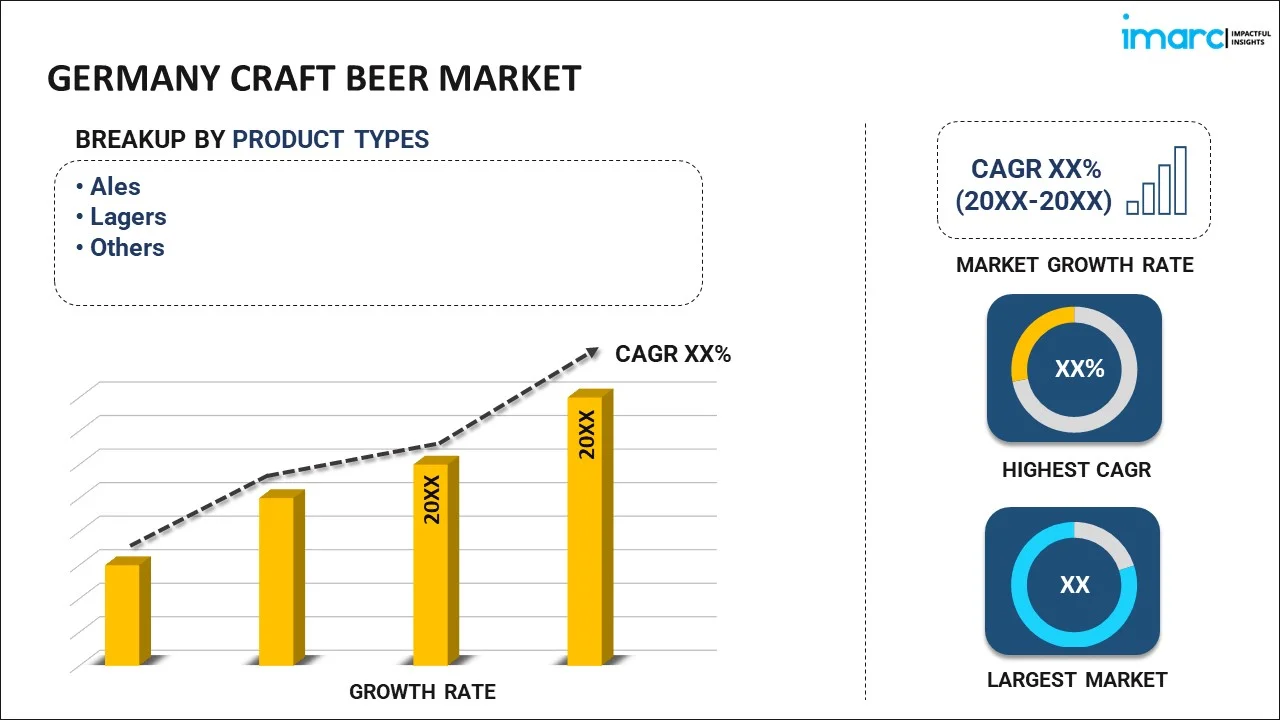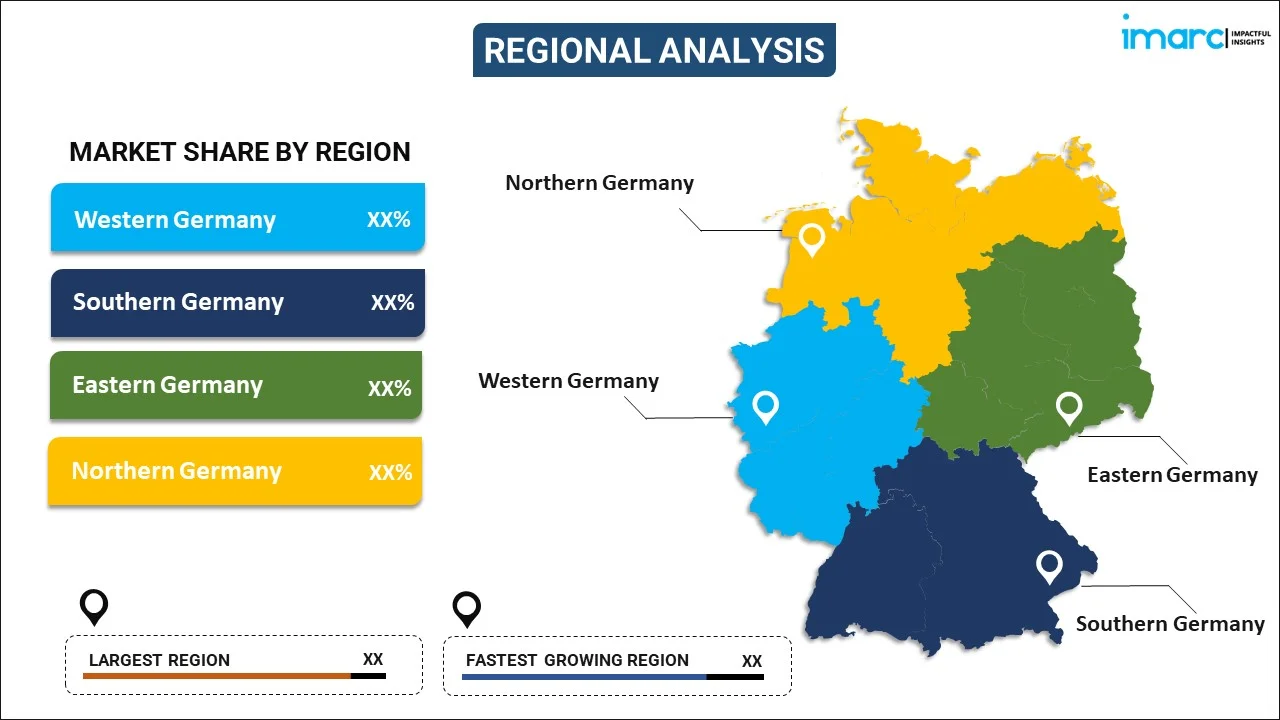
Germany Craft Beer Market Report by Product Type (Ales, Lagers, and Others), Age Group (21-35 Years Old, 40-54 Years Old, 55 Years and Above), Distribution Channel (On-Trade, Off-Trade), and Region 2025-2033
Germany Craft Beer Market Overview:
The Germany craft beer market size reached USD 6.4 Billion in 2024. Looking forward, IMARC Group expects the market to reach USD 10.9 Billion by 2033, exhibiting a growth rate (CAGR) of 6.05% during 2025-2033. The shifting trends toward craft and specialty beers, rise of beer tourism, beer festivals, and tasting events, innovative brewing techniques, and increasing interest in locally produced and artisanal products represent some of the key factors driving the growth of the market.
|
Report Attribute
|
Key Statistics
|
|---|---|
|
Base Year
|
2024
|
|
Forecast Years
|
2025-2033
|
|
Historical Years
|
2019-2024
|
|
Market Size in 2024
|
USD 6.4 Billion |
|
Market Forecast in 2033
|
USD 10.9 Billion |
| Market Growth Rate 2025-2033 | 6.05% |
Germany Craft Beer Market Trends:
Trend Towards Craft and Specialty Beers
The craft beer market in Germany is being driven by the increasing consumer appreciation for craft and specialty beers. This trend reflects a shift towards sourcing from independent and local producers, and a preference for unique, high-quality flavors and ingredients that distinguish craft beers from industrial beers. The continuing rise in beer tourism and brewery tours also contribute to this development. For instance, around 1,500 breweries are spread across the country (half of them in Bavaria), Germany holds the record for the highest number of breweries in Europe. This extensive network of breweries contributes significantly to the German economy, generating substantial revenue and providing employment for a large number of people, tens of thousands working directly for the breweries, and hundreds of thousands more working for the hospitality sector that depends on the beer market. Beer is currently an €8.5 billion German industry and contributes about 1.5% of GDP of Europe’s largest economy. Additionally, the rising popularity of beer festivals and tasting events is on the rise in Germany is boosting beer consumption. The high quality and diverse range of craft beers foster a strong consumer attachment to the product, contributing to continuous market growth.
Impact of Microbreweries and Brewpubs
Microbreweries or brewpubs are also on the rise in Germany, thus boosting the growth of the craft beer market. Some of them exist solely for offering a range of new and unique beers, but all of them contribute to the improvement of the beer drinking experience in the region in terms of local identity and togetherness. Brewpubs, where beer is brewed for on-site consumption, facilitate direct customer interactions and enhance brand building. Also, there is a social support, including government assistance to small scale breweries and the favourable policies, created to enable many entrepreneurs to venture into this business. For instance, after being approved by the lower house (Bundestag), the upper house of the German parliament (Bundesrat) has also voted in favor of a temporary lowering of beer tax for smaller breweries in Germany on May 28, 2021. This has culminated in the influx of competition and creativity in the craft beer segment, a factor which has seen cask beer consumers being presented with a myriad of choices and consequently a segment contributor to the total growth of the market.
Germany Craft Beer Market News:
- In March 2024, Paulaner Brauerei Munchen launched the Paulaner Limo Orange, which is a non-alcoholic beer, in the German market. Its iconic wave design marks it as part of the the Paulaner Spezi family.
- In March 2024, Krombacher Brewery, one of Germany's leading brewing groups, is set to roll out the Starnberger Hell, an authentic Bavarian lager-style specialty, across several European countries and regions.
Germany Craft Beer Market Segmentation:
IMARC Group provides an analysis of the key trends in each segment of the market, along with forecasts at the country level for 2025-2033. Our report has categorized the market based on product type, age group, and distribution channel.
Product Type Insights:

- Ales
- Lagers
- Others
The report has provided a detailed breakup and analysis of the market based on the product type. This includes ales, lagers, and others.
Age Group Insights:
- 21-35 Years Old
- 40-54 Years Old
- 55 Years and Above
A detailed breakup and analysis of the market based on the age group have also been provided in the report. This includes 21-35 years old, 40-54 years old, and 55 years and above.
Distribution Channel Insights:
- On-Trade
- Off-Trade
The report has provided a detailed breakup and analysis of the market based on the distribution channel. This includes on-trade, and off-trade.
Regional Insights:

- Western Germany
- Southern Germany
- Eastern Germany
- Northern Germany
The report has also provided a comprehensive analysis of all the major regional markets, which include Western Germany, Southern Germany, Eastern Germany, and Northern Germany.
Competitive Landscape:
The market research report has also provided a comprehensive analysis of the competitive landscape in the market. Competitive analysis such as market structure, key player positioning, top winning strategies, competitive dashboard, and company evaluation quadrant has been covered in the report. Also, detailed profiles of all major companies have been provided.
Germany Craft Beer Market Report Coverage:
| Report Features | Details |
|---|---|
| Base Year of the Analysis | 2024 |
| Historical Period | 2019-2024 |
| Forecast Period | 2025-2033 |
| Units | Billion USD |
| Scope of the Report | Exploration of Historical and Forecast Trends, Industry Catalysts and Challenges, Segment-Wise Historical and Predictive Market Assessment:
|
| Product Types Covered | Ales, Lagers, Others |
| Age Groups Covered | 21-35 Years Old, 40-54 Years Old, 55 Years and Above |
| Distribution Channels Covered | On-Trade, Off-Trade |
| Regions Covered | Western Germany, Southern Germany, Eastern Germany, Northern Germany |
| Customization Scope | 10% Free Customization |
| Post-Sale Analyst Support | 10-12 Weeks |
| Delivery Format | PDF and Excel through Email (We can also provide the editable version of the report in PPT/Word format on special request) |
Key Questions Answered in This Report:
- How has the Germany craft beer market performed so far and how will it perform in the coming years?
- What has been the impact of COVID-19 on the Germany craft beer market?
- What is the breakup of the Germany craft beer market on the basis of product type?
- What is the breakup of the Germany craft beer market on the basis of age group?
- What is the breakup of the Germany craft beer market on the basis of distribution channel?
- What are the various stages in the value chain of the Germany craft beer market?
- What are the key driving factors and challenges in the Germany craft beer?
- What is the structure of the Germany craft beer market and who are the key players?
- What is the degree of competition in the Germany craft beer market?
Key Benefits for Stakeholders:
- IMARC’s industry report offers a comprehensive quantitative analysis of various market segments, historical and current market trends, market forecasts, and dynamics of the Germany craft beer market from 2019-2033.
- The research report provides the latest information on the market drivers, challenges, and opportunities in the Germany craft beer market.
- Porter's five forces analysis assist stakeholders in assessing the impact of new entrants, competitive rivalry, supplier power, buyer power, and the threat of substitution. It helps stakeholders to analyze the level of competition within the Germany craft beer industry and its attractiveness.
- Competitive landscape allows stakeholders to understand their competitive environment and provides an insight into the current positions of key players in the market.
Need more help?
- Speak to our experienced analysts for insights on the current market scenarios.
- Include additional segments and countries to customize the report as per your requirement.
- Gain an unparalleled competitive advantage in your domain by understanding how to utilize the report and positively impacting your operations and revenue.
- For further assistance, please connect with our analysts.
 Inquire Before Buying
Inquire Before Buying
 Speak to an Analyst
Speak to an Analyst
 Request Brochure
Request Brochure
 Request Customization
Request Customization




.webp)




.webp)












